First Canadian Army
The First Canadian Army (French: 1reArmée canadienne) was a field army and a formation of the Canadian Army in World War II in which most Canadian elements serving in North-West Europe were assigned. It served on the Western Front from July 1944 until May 1945.
| First Canadian Army | |
|---|---|
 Formation patch worn by army-level personnel. | |
| Active | 1942–1946 |
| Country | Canada |
| Branch | Canadian Army |
| Type | Field army |
| Role | Canadian Army force also with UK and other national elements World War II. |
| Size | 251,000 |
| Part of | 21st Army Group |
| Commanders | |
| 1942–1943 | Andrew McNaughton |
| 1943–1944 | Kenneth Stuart (acting) |
| 1944 | Guy Simonds (acting) |
| 1944–1945 | Harry Crerar |
The army was formed in early 1942, replacing the existing unnumbered Canadian Corps, as the growing contribution of Canadian forces to serve with the British Army in the United Kingdom necessitated an expansion to two corps. By the end of 1943 Canadian formations consisted of three infantry divisions, two armoured divisions and two independent armoured brigades. The first commander was Lieutenant-General A. G. L. "Andy" McNaughton, who was replaced in 1944 by General H. D. G. "Harry" Crerar. Both had been senior Royal Regiment of Canadian Artillery officers in the Canadian Corps in World War I. Allied formations of other nationalities were added to the First Canadian Army to keep it at full strength.[1]
The First Canadian Army's strength was 177,000 all ranks at the end of 1942. One year later it had grown to 242,000. On 31 May 1944, shortly before the Normandy landings, Canadian troops in Europe numbered 251,000 of which 75,000 had left First Canadian Army to serve on the Italian Front.[2]
History
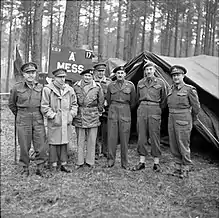
When the First Canadian Army was formed overseas in 1942, Lieutenant-General Andrew McNaughton's aim was to keep Canada's contributions to the British Army together to lead the cross-channel assault on northwest Europe.[1] Two brigades of the 2nd Canadian Division led the ill-fated Dieppe Raid in 1942.[3] Aside from this endeavour, the Army did not see combat until July 1943. In 1943, because the Canadian government wanted Canadian troops to see action immediately,[4] the 1st Canadian Infantry Division, 1st Canadian Armoured Brigade, and 5th Canadian Armoured Division were detached from the Army for participation in the Italian Campaign.[5]
In early 1944, the 3rd Canadian Infantry Division and 2nd Canadian Armoured Brigade were also detached to British I Corps to participate in the assault phase of the Normandy landings. II Canadian Corps became operational in Normandy in early July 1944, as the 2nd Canadian Infantry Division landed. The First Canadian Army headquarters did not itself arrive in Normandy until mid-July, becoming operational on 23 July 1944 just before 4th Canadian Armoured Division arriving on the Continent.
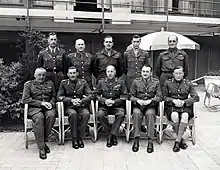
The Army proper first went into action in the Battle of Normandy and conducted operations at Falaise (e.g. Operation Totalize, Operation Tractable) and helping close the Falaise pocket. After reaching the Seine, the objective of the first phase of Operation Overlord, the Army moved along the coast towards Belgium, with the Canadian 2nd Division entering Dieppe at the beginning of September. The First Army, under acting command of Lieutenant-General Guy Simonds (from 28 September 1944 to 7 November 1944), fought the critical Battle of the Scheldt along with the supporting Operation Pheasant in October and early November, opening Antwerp for Allied shipping.
The First Canadian Army held a static line along the river Meuse (Maas) from December through February, then launched Operation Veritable in early February. By this point, the Army, besides the II Canadian Corps, contained nine British divisions. The Siegfried Line was broken and the Army reached the banks of the Rhine in early March.
In the final weeks of the war in Europe, the First Army cleared the Netherlands of German forces. By this time the First Division and Fifth (Armoured) Division as well as First Armoured Brigade and the 1st Cdn AGRA had returned to the Army during Operation Goldflake and for the first time, both the I Canadian Corps and II Canadian Corps fought under the same Army commander.
Makeup
The First Canadian Army was international in character. The size of Canada's military contribution on its own would likely not have justified the creation of a separate army-level command in North-West Europe, especially over the period when I Canadian Corps was away gaining valuable combat experience in Italy. However, both McNaughton and Crerar, backed up by the Canadian government, were successful in their lobbying for the British Army to create a Canadian-led army enlarged with contributions from other Allied countries. In addition to II Canadian Corps (which included the Canadian formations under command described above), other formations under command included the British I Corps, and the 1st Polish Armoured Division, as well as, at various times, the American 104th Infantry Division (Timberwolf), 1st Belgian Infantry Brigade, Royal Netherlands Motorized Infantry Brigade and 1st Czechoslovak Armoured Brigade. The First Canadian Army in North-West Europe during the final phases of the war comprised the largest field army ever under the control of a Canadian general. Ration strength of the army ranged from approximately 105,000 to 175,000 Canadian soldiers to anywhere from 200,000 to over 450,000 when including the soldiers from other nations.
The 'Maple Leaf Route' was the designation of the army's main supply route. The route was usually divided into Maple Leaf Up and Maple Leaf Down, designating traffic to and away from the front, respectively.
Order of battle
Second World War 1939–1945[6]
 First Canadian Army
First Canadian Army
- Headquarters
- First Canadian Army Defence Battalion - Lorne Scots (until April 1944) & Royal Montreal Regiment
- No. 1 Army Headquarters Car Company, Royal Canadian Army Service Corps (RCASC)
- Royal Canadian Artillery
 No. 1 Army Group, R.C.A.(1st Cdn AGRA)
No. 1 Army Group, R.C.A.(1st Cdn AGRA)
- 11th Army Field Regiment
- 1st Medium Regiment, Royal Canadian Artillery
- 2nd Medium Regiment, Royal Canadian Artillery
- 5th Medium Regiment, Royal Canadian Artillery
- 56th Heavy Regiment, Royal Artillery (from Mar 1945)
 No. 2 Army Group, R.C.A.(2nd Cdn AGRA)
No. 2 Army Group, R.C.A.(2nd Cdn AGRA)
- 19th Army Field Regiment
- 3rd Medium Regiment, Royal Canadian Artillery
- 4th Medium Regiment, Royal Canadian Artillery
- 7th Medium Regiment, Royal Canadian Artillery
- 10th Medium Regiment, Royal Artillery
- 15th Medium Regiment, Royal Artillery, (disb Dec 44)
- 1st Heavy Regiment, Royal Artillery
- 2nd Heavy Anti-Aircraft Regiment (Mobile)
- 1st Rocket Battery
- 1st Radar Battery
- "F" Squadron, 25th Armoured Delivery Regiment (The Elgin Regiment), Canadian Armoured Corps (CAC)
- 1st Armoured Personnel Carrier Regiment, CAC
- No. 6 Casualty Clearing Station, Royal Canadian Army Medical Corps (RCAMC)
- Nos. 4, 5, 6 & 7 Field Transfusion Units, RCAMC
- Nos. 9, 10 & 11 Field Dressing Stations, RCAMC
- No. 14 Field Hygiene Section, RCAMC
- units of the Canadian Dental Corps (CDC)
- Nos. 81 & 82 Artillery Companies, RCASC
- Nos. 35 & 36 Army Troops Composite Companies, RCASC
- Nos. 41, 45, 47, 63 & 64 Army Transport Companies, RCASC
- Nos. 1 & 2 Motor Ambulance Convoys, RCASC
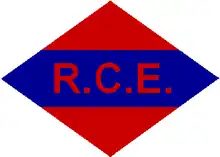 Royal Canadian Engineers
Royal Canadian Engineers
- First Canadian Army Troops Engineers
- 10th Field Park Company
- 5th, 20th & 23rd Field Companies
- 2nd Canadian Army Troops Engineers
- 11th Field Park Company
- 32nd, 33rd & 34th Field Companies
- No. 1 Workshop and Park Company
- 1st Field (Air) Survey Company
- 2nd Field Survey Company
- 3rd Field (Reproduction) Company
- First Canadian Army Troops Engineers
- First Army Signals, Royal Canadian Corps of Signals (RCCS)
- 1st Air Support Signals Unit
- Nos. 1, 2 & 3 Special Wireless Sections
- First Army Troops Workshop, Royal Canadian Electrical and Mechanical Engineers
- No. 11 Provost Company, Canadian Provost Corps
- No. 1 Canadian Forestry Group, Canadian Forestry Corps
- No. 1 Army Base Post Office, Canadian Postal Corps
 I Canadian Corps (April 1942 to November 1943; February to July 1945)
I Canadian Corps (April 1942 to November 1943; February to July 1945)
- (attached to the British Eighth Army in Italy from November 1943 to February 1945)
 1st Canadian Infantry Division (in Italy from July 1943 to February 1945)
1st Canadian Infantry Division (in Italy from July 1943 to February 1945) 5th Canadian Armoured Division
5th Canadian Armoured Division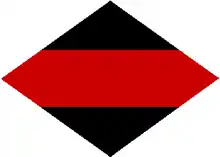 1st Canadian Armoured Brigade
1st Canadian Armoured Brigade- 1st Corps Defence Company (Lorne Scots)
- Other Corps Troops
 II Canadian Corps (January 15, 1943, to June 25, 1945)
II Canadian Corps (January 15, 1943, to June 25, 1945)
 I British Corps (August 1, 1944, to April 1, 1945)
I British Corps (August 1, 1944, to April 1, 1945)
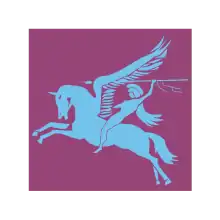 6th Airborne Division (to 3 September 1944)
6th Airborne Division (to 3 September 1944)
 1st Belgian Infantry Brigade (August 10 to September 10, 1944)
1st Belgian Infantry Brigade (August 10 to September 10, 1944)
.jpg.webp) 49th (West Riding) Infantry Division
49th (West Riding) Infantry Division 51st (Highland) Infantry Division (to 19 December 1944)
51st (Highland) Infantry Division (to 19 December 1944)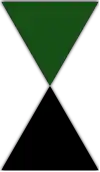 33rd Armoured Brigade (to September 1944)
33rd Armoured Brigade (to September 1944) 104th Infantry Division (United States) (mid October to early November, 1944)
104th Infantry Division (United States) (mid October to early November, 1944)
 XXX British Corps (January to March, 1945 for Operation Veritable)
XXX British Corps (January to March, 1945 for Operation Veritable)
- Headquarters
Commanders
- Andrew McNaughton (Commander, early 1942 – 21 December 1943)[7]
- Kenneth Stuart (Acting Commander, 21 December 1943 – 20 March 1944)[8]
- Harry Crerar (Commander, 20 March 1944 – summer 1945)[7]
- Guy Simonds (Acting Commander from 28 September to 7 November 1944)[7]
References
- Harris, Stephen. "First Canadian Army". The Canadian Encyclopedia. Historica Foundation. Retrieved on: 2011-12-23
- Stacey, C.P (1948). "Chapter III New Tasks and Problems, 1941–1942". The Canadian Army 1939–1945, An Official Historical Summary. Retrieved 2011-12-23 – via Patrick Clancey, HyperWar Foundation.
{{cite book}}:|work=ignored (help) - Stacey, C.P (1948). "Chapter V The Raid on Dieppe, 19 August 1942". The Canadian Army 1939-1945. Official History of the Canadian Army In the Second World War. p. 65. Retrieved 2012-12-24 – via Hyperwar Foundation.
- Stacey, C.P. (1948). Chapter VI Canadian Troops Go to the Mediterranean. Retrieved on: 2012-12-24.
- Stacey, C.P. (1948). Chapter VII The Italian Campaign: Sicily and Southern Italy, July–November 1943. Retrieved on: 2012-12-24.
- "Structure of the Canadian Army from 1900 to 2000". canadiansoldiers. Retrieved 2011-12-24.
- Bernd Horn; Stephen John Harris (2001). Warrior chiefs: perspectives on senior Canadian military leaders. Dundurn Press Ltd. ISBN 978-1-55002-351-0.
- J. L. Granatstein (July 2005). The generals: the Canadian army's senior commanders in the Second World War. University of Calgary Press. p. 50. ISBN 978-1-55238-176-2.
Further reading
- Copp, Terry (29 July 2004). Fields of Fire: The Canadians in Normandy. University of Toronto Press. ISBN 978-0-8020-3780-0.
- Copp, Terry (10 October 2007). The Brigade: The Fifth Canadian Infantry Brigade in World War II. Stackpole Books. ISBN 978-0-8117-3422-6.
- Angus Brown; Richard Howard Gimblett (May 2009). In the footsteps of the First Canadian Army: northwest Europe 1942–1945. Magic Light Pub. ISBN 978-1-894673-33-4.
- Zuehlke, Mark (13 March 2012). Breakout from Juno: First Canadian Army and the Normandy Campaign, July 4 – August 21, 1944. Douglas & McIntyre. ISBN 978-1-55365-325-7.
- Zuehlke, Mark (1 April 2009). Terrible Victory: First Canadian Army and the Scheldt Estuary Campaign: September 13 – November 6, 1944. Douglas & McIntyre. ISBN 978-1-55365-404-9.
- Robin Dickers (2012). The History of the 2nd Canadian Army Group Royal Artillery. London: Lonsdale. ISBN 978-0-9569969-9-2.
- Official accounts – National Defence and the Canadian Forces
- Stacey, C P. (1955) Volume I Six Years of War: The Army in Canada, Britain and the Pacific, Official History of the Canadian Army in the Second World War. Queen's Printer, Ottawa
- Nicholson, G W L (1956). Volume II The Canadians in Italy. Official history of the Canadian Army in the Second World War. Queen's Printer, Ottawa. Archived from the original on 2012-05-31.
- Stacey, C P. (1960) , Volume III The Victory Campaign: The Operations in Northwest Europe, 1944–45 Official History of the Canadian Army in the Second World War, Queen's Printer, Ottawa
External links
- canadiansoldiers.com page
- The First Canadian Army – Veterans Affairs Canada
- First Canadian Army, 8 May 1945 – Juno Beach Centre